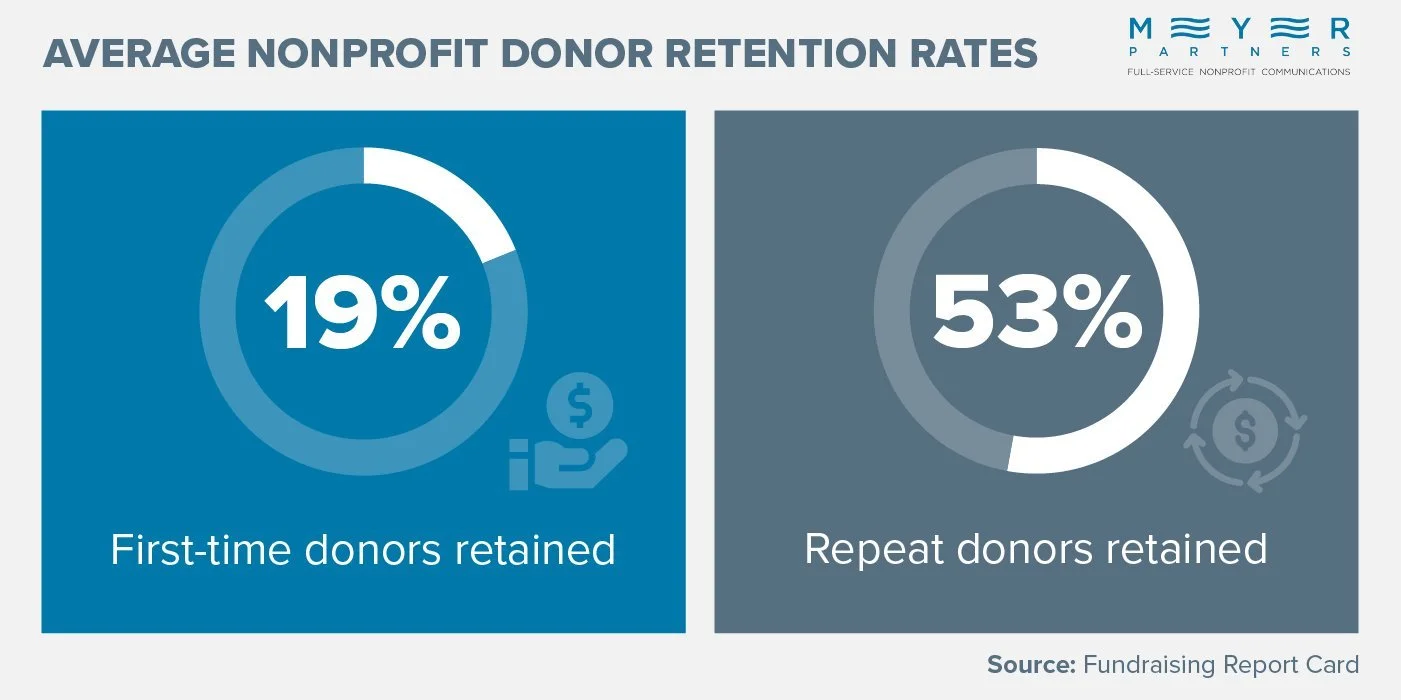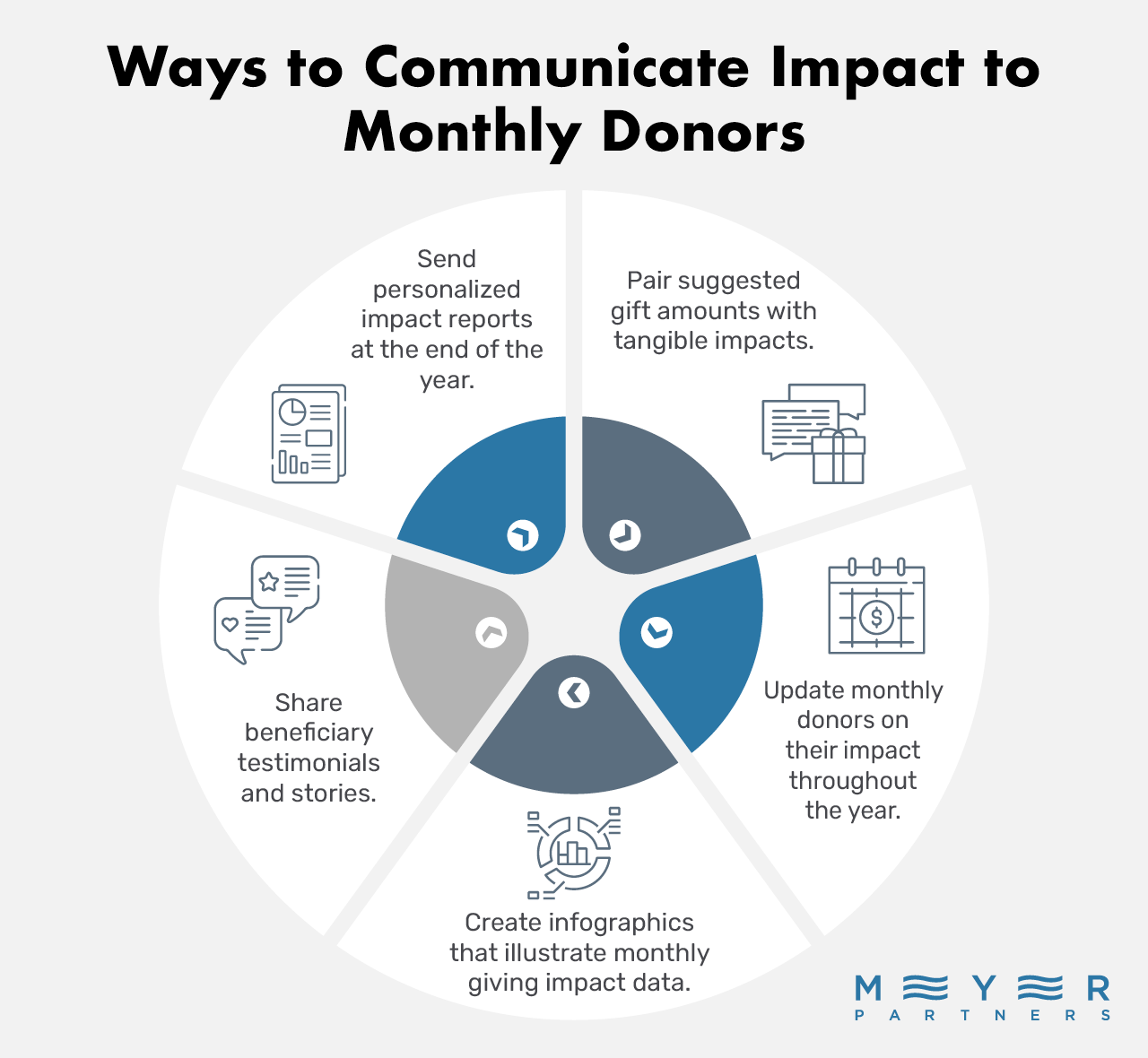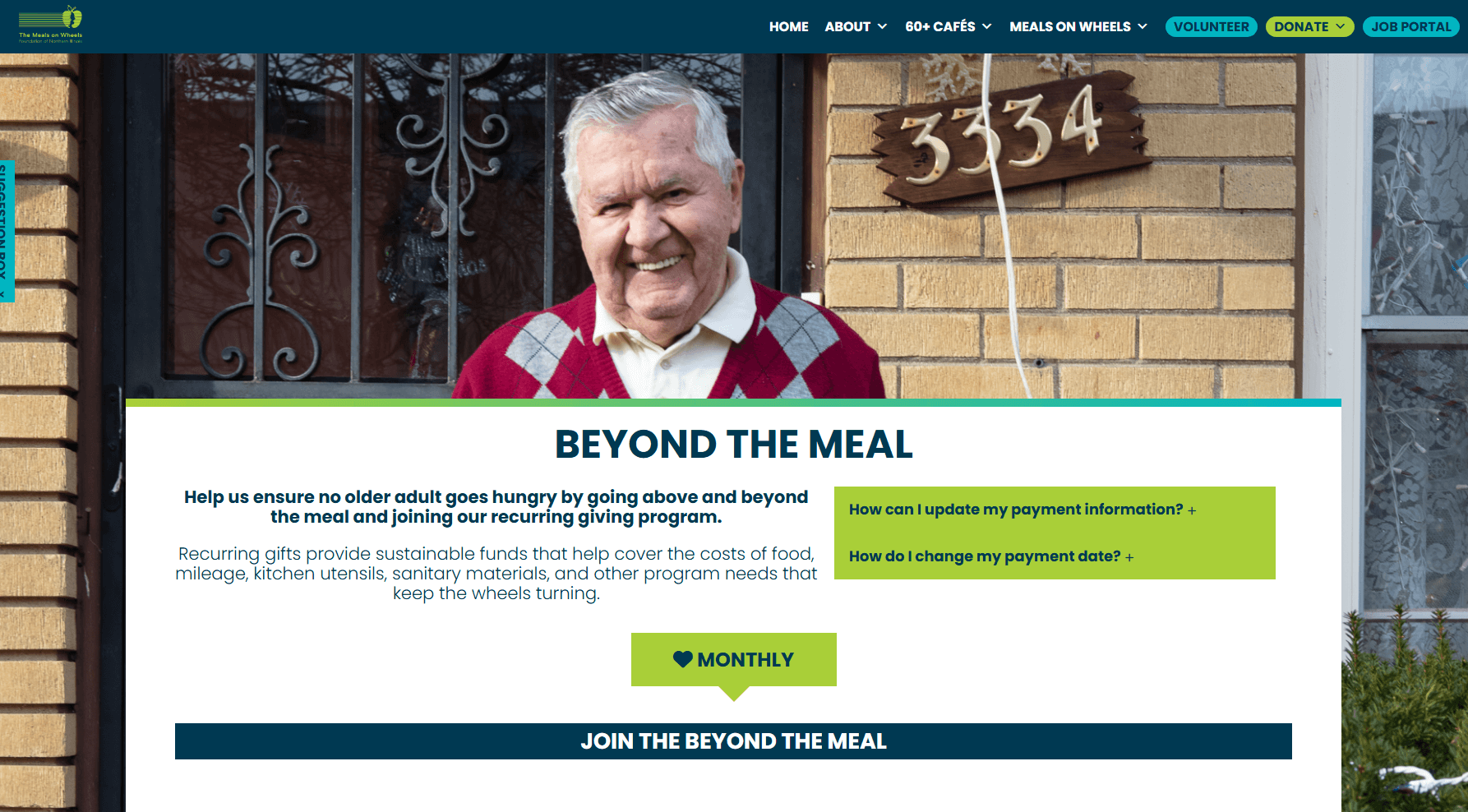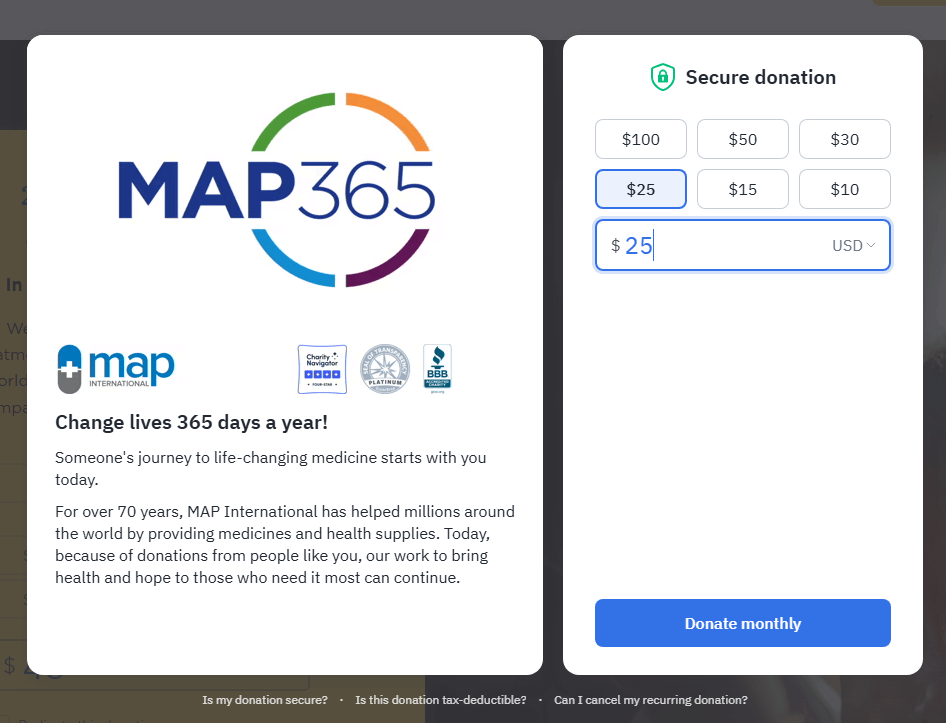Monthly Giving Programs: How to Drive Recurring Revenue
Monthly giving programs help nonprofits earn regular, reliable income from loyal donors.
Even as the economy fluctuates and charitable giving behaviors change, monthly giving remains strong. According to the 2025 M+R Benchmarks, monthly donations accounted for 31% of all online revenue last year, and nonprofits saw a 5% increase in overall revenue from monthly gifts.
Clearly, this is a fundraising avenue you need to tap into. If you’re new to monthly giving or just want to improve your organization’s strategy, this guide will cover all the essentials. We’ll discuss:
With the right communications strategy, you can secure steady, predictable funding while deepening relationships with supporters. Let’s start with the basics of monthly giving.
What is Monthly Giving?
Monthly gifts are a type of charitable donation that recurs each month. Typically, a donor will sign up to give the same amount (such as $50) to a nonprofit once a month. Then, the nonprofit automatically charges the donor’s credit card for that amount on the same day every month. It’s an easy way to provide ongoing support for an organization without navigating to its donation page and filling out a form every time.
While some nonprofits use monthly giving and recurring giving interchangeably, monthly donations are a specific type of recurring giving that occurs on a monthly basis.
Recurring Giving Benefits
The reason monthly giving is so popular with donors and nonprofits alike is that it offers so many appealing benefits, including:
For Nonprofits
Getting a reliable, sustained revenue stream: When your organization has several monthly donors, you can make more confident projections of how much fundraising revenue you’ll earn each month. If you know that 20 donors give $100 monthly, for example, you can expect at least $2,000 in recurring revenue each month. This steady source of reliable income makes goal-setting and budgeting easier.
Attracting donors who want easy giving: Many donors opt for recurring giving because it’s easier and more convenient than one-time donations. By providing the opportunity to simplify giving and promoting it across channels, you may acquire new donors who are looking for easy ways to support charitable causes.
Higher donor retention rates: Monthly gifts naturally lead to donors sticking around longer. Since donations are deducted automatically, supporters won’t forget to give again, prolonging their relationships with your nonprofit. Plus, every monthly donor gives at least twice, and repeat donors have significantly higher retention rates. The Fundraising Report Card reports that nonprofits retain 53% of repeat donors year-to-year and only 19% of one-time donors.
Increased donor lifetime value: Monthly donors tend to engage with your organization for several years, and their regular gifts add up. This means that many of them have higher donor lifetime values (LTVs) and ultimately contribute more to your nonprofit over time than sporadic donors.
For Donors
Easy, convenient giving: Giving automatic monthly gifts is much easier than remembering to donate, finding your donation page, and filling out a form multiple times a year. Think of it like a subscription—most of your donors already subscribe to streaming and delivery services and pay set fees each month without thinking about it. Why not add giving to your nonprofit to the mix?
Ability to give in larger amounts over time: A supporter may not be able to make a one-time $1,200 contribution, no matter how much they want to. However, maybe they can fit smaller $100 donations into their budget each month. By giving a little at a time, many donors are able to contribute much more than they think they can.
Long-term impact: Sustained giving equals sustained impact. Donors who give on a regular basis can rest assured that they’re always making a difference and working to further your mission. The longer they remain a monthly donor, the more long-term personal impact they can make on your cause.
Exclusive perks and incentives for recurring donors: Many nonprofits offer fun perks to monthly donors as part of their programs. When they do, joining a recurring giving program feels like joining an exclusive club complete with exciting benefits. Donors may get access to specialized merch, exclusive events, early-bird discounts, and more.
For Both Nonprofits and Donors
More funding to support your mission: A thriving monthly giving program naturally results in more funding for your organization’s programs, services, advocacy, and other types of work. Everyone in your community wants your mission to succeed, and monthly donations increase the resources you have to get there.
Streamlined giving process: An automated donation process benefits both supporters and nonprofit staff by reducing the hassle involved in giving. Donors can give each month without thinking about it or taking any time out of their days, and nonprofits can spend less time and money convincing supporters to give again.
Improved sense of community: Regular giving increases donors’ involvement and impact on your nonprofit, making them feel like more active participants in your organization’s community. These feelings improve relationships and increase retention, helping your nonprofit maintain a large base of engaged supporters.
How to Ask for Monthly Gifts
Follow these four simple steps to start tapping into the benefits of monthly giving.
1. Optimize Your Donation Page for Monthly Donations
First, ensure that it’s possible and easy to make monthly contributions from your website’s donation page. Supporters shouldn’t have to look for the option to give monthly—it should be front and center.
Typically, this means incorporating a selection to “Give Once” or “Give Monthly” on your donation form. Many organizations set up their pages to automatically select “Give Monthly” to encourage more recurring gifts. Either way, the choice should be clear and transparent. Make sure visitors know that selecting “Give Monthly” will automatically process monthly payments, and give them the option to choose what day the transactions go through.
We also recommend including a brief statement about why supporters should consider monthly gifts on your donation page. Even a short call to action (CTA) like “Maximize your impact!” or “Support injured animals every day by giving monthly” can make a big difference.
2. Set Suggested Monthly Giving Amounts
Next, include a few suggested giving amounts on your donation form to guide potential donors. Base your suggestions on the average monthly gift to your nonprofit, or round up to encourage slightly larger donations.
If you have room on your donation page or if your embedded giving form supports it, add brief descriptions of each giving amount’s potential impact, too. This could look like:
A $25 monthly gift provides clean-water testing kits to five families a month.
A $50 monthly gift funds the maintenance of two community gardens.
A $100 monthly gift provides life-saving medical care to an animal affected by pollution.
With tangible impacts connected to each amount, visitors to your donation page will be more compelled to give at the level that suits them. They’ll have a better understanding of what monthly gifts can do and how they can personally play a part in furthering your organization’s mission long-term.
3. Identify Prospects
While anyone might be interested in monthly giving (new and repeat donors alike), some individuals are more likely to participate than others. For instance, brand-new donors who gave small or mid-level gifts might want an easy way to keep contributing. Frequent donors (those who already give 2-3+ times annually) are another great set of prospects. Refer to your donor pyramid, and identify prospects from your first-time, repeat, and annual donor segments.
Focusing on these prospects and reaching out to them directly is a great way to start promoting your recurring giving program.
Send personalized communications that introduce the idea of monthly giving, explain the benefits, and provide instructions on how to participate. Tailor these messages to each person as much as possible—include their most recent donation amount or the aspect of your cause they like to support the most.
For instance, you might send an email like this:
Olandria, thanks for being a long-time supporter of our cause! Your contributions have provided crucial support for injured birds, but did you know you can make an even greater impact with recurring giving? Turn your regular $100 donation into a monthly gift, or choose a different amount that fits into your budget. It’s easy—once you sign up here, everything’s automatic!y.
If you need help identifying prospects, consider working with our team at Meyer Partners. Our predictive analytics services allow us to mine your data house files and model donor behavior with incredible accuracy, identifying those most likely to become a sustainer.
4. Promote Recurring Giving Across Channels
Don’t stop with individual outreach—promote your new monthly giving program using all your nonprofit’s marketing channels to spread the word about the opportunity. This includes marketing efforts like:
Direct mail appeals and updates
Your website’s homepage, donation page, and blog posts
Email newsletters
Social media posts across platforms
Physical flyers and handouts
Text messages
Event communications
Phone calls with donors
Each of these channels should work together to promote your recurring giving program to different audiences. For example, take a look at how this direct mail appeal our marketing consultants created for Concordia University integrates direct mail, their website, and phone calls to advertise monthly giving:
This appeal includes a card featuring “Ways to Maximize Your Gift,” like monthly giving. It emphasizes that automatic monthly gifts are the easiest way to donate and impact students, highlighting their security, environmental friendliness, and convenience for donors. Then, the appeal directs readers to give online or by calling an advancement officer.
Tips for Building a Thriving Monthly Giving Program
To increase your revenue opportunities and convince more supporters to give regularly, follow these best practices.
Make Monthly Giving Easy
As we mentioned earlier, making it easy to give monthly starts with your donation page. But beyond including a clear option for monthly gifts and a few suggested donation amounts, what else can you do?
Improve the simplicity of giving on your donation page by:
Limiting form fields to the necessities (gift amount, contact information, and contact details).
Optimizing your donation page for mobile devices.
Making your donation form the focal point of the page and limiting other content.
Linking to another page about monthly giving, where they can learn more.
Simplifying language and including multiple language options if relevant.
Making monthly giving the default selection.
Providing multiple payment options (credit card, Apple Pay, Google Pay, etc.)
Once you’ve made these changes, monitor the page’s performance regularly. Pay attention to the percentage of recurring gifts vs. one-time gifts, and analyze metrics like conversion rate, bounce rate, and time spent on the page. Make adjustments as needed and keep monitoring to gauge their impact.
Incorporate Monthly Donations into Your Broader Fundraising Strategy
Monthly giving is a great strategy on its own, but you can earn more fundraising revenue from these donations if you incorporate them into your wider strategy. Highlight monthly gifts as an option in annual donation appeals, year-end giving campaigns, fundraising events, and one-off campaigns throughout the year. Keep reminding donors of the benefits, and thank those who sign up.
Name Your Monthly Giving Program
Giving your program a name creates a unique identity for monthly donors and sets them apart from one-time supporters. This can encourage more people to join, improve their experiences once they do so, and make them feel like special members of your community.
Consider names that speak to your mission and the act of regular giving. For instance, an animal rescue nonprofit might name its program “Wildlife Warriors” or “Rescue Never Stops.” If you’re not sure what to name your program, consider asking current monthly donors for ideas! They could even vote on the top three choices so everyone has a say.
Once you have a name, include it on your website’s monthly giving page and in all communications with recurring donors going forward.
Offer Incentives or Membership Tiers
Special perks can sweeten the deal for prospective monthly donors and inspire more people to join. They can also bring recurring supporters together and encourage them to keep giving long-term.
Incentives offered to monthly donors might include:
Custom merchandise like t-shirts, stickers, or water bottles with the program’s name
Invitations to monthly donor-only events
Exclusive updates on your work or upcoming events
Special recognition on social media or in newsletters
Discounts on gala tickets
Extra opportunities to provide feedback or vote on potential offerings
Personalized thank-you messages from beneficiaries or volunteers
You might offer all of these benefits to monthly donors, regardless of how much they give. Or, you could create a few donation or membership tiers for different giving levels. For example, donors who give over $100 monthly could get extra perks than those who give $50-100.
Create a Community of Monthly Donors
Communicating regularly with donors is vital for keeping them engaged in your program, especially when their donations come through automatically. Make sure to remind them of their involvement often and emphasize that they’re part of a generous community of cause advocates.
To foster a sense of community, you might send special newsletters to monthly donors or schedule periodic meetups for donors. Monitor engagement with these communications to determine how much they appeal to your donors, and adjust your strategy accordingly.
Communicate Impact Regularly
Since recurring donors make their contributions automatically, they may not pay as much attention to your nonprofit's daily operations or understand the real impact they’re making.
To keep them engaged, try the following strategies for communicating impact more effectively:
Pair suggested gift amounts with tangible impacts. This way, donors will have a clear idea of their potential impact even before they donate.
Update monthly donors on their impact throughout the year. Send quarterly updates that tell monthly donors how much they’ve contributed and what initiatives their dollars have supported.
Create infographics that illustrate monthly giving impact data. Visuals communicate information more quickly than words. Design and share a few simple impact graphics that illustrate how much monthly donors give, how many programs they support, etc.
Share beneficiary testimonials and stories. Use storytelling to paint a picture of donors’ impact on the real people your nonprofit serves. Share quotes from beneficiaries in your email and direct mail updates to appeal to readers’ emotions.
Send personalized impact reports at the end of the year. When you create your annual report, consider sending short breakdowns of each monthly donor’s personal impact that year. Share their total amount donated and how it supported your mission.
Driving more impact is a core reason that people become monthly donors, so make sure they understand the real value of their donations at all times.
Highlight Monthly Giving in Direct Mail Appeals
Direct mail is a particularly effective channel for promoting your monthly giving program and keeping in touch with donors. This is because direct mail:
Feels more personal than emails or social media content.
Reaches the donors who don’t open or read your emails.
Provides a tangible reminder of your organization that donors can hold onto.
Easily integrates with other marketing channels with links and QR codes.
To highlight monthly giving opportunities in your next direct mail communications, include brief information about your program, its benefits, and how to sign up. Add a QR code so recipients can quickly scan it to access your donation page on their phones.
If you want to get started with direct mail or improve your strategy to reach more donors, consider working with a marketing agency like Meyer Partners. Our consultants are well-versed in nonprofits’ fundraising needs, the ins and outs of direct mail marketing, and immersive nonprofit storytelling. We can help you design standout monthly giving appeals or make holistic improvements to your communications strategy. Contact our team to learn more.
Keep in Touch with Recurring Donors
Recurring donors need stewardship, too. Not only are they valuable members of your community that you want to retain, but they’re often great prospects for planned giving. Communicate with them regularly and keep strengthening relationships with periodic outreach.
For monthly donors, this typically includes sending thank-you emails, sharing impact data, and reminding them when their payment method is about to expire. However, you can take stewardship further by inviting monthly donors to events and volunteer opportunities that resonate with their unique interests.
3 Successful Monthly Giving Program Examples
Now that you know the basics, let’s explore what a successful monthly giving program looks like in practice. Here are a few examples from organizations we’ve worked with:
Meals on Wheels of Northern Illinois
The Northern Illinois chapter of Meals on Wheels has a monthly giving club called “Beyond the Meal.” On the organization’s program page, it explains that “Recurring gifts provide sustainable funds that help cover the costs of food, mileage, kitchen utensils, sanitary materials, and other program needs that keep the wheels turning.”
We love how this program’s name quickly communicates the additional impact monthly donors can make. The program page also includes FAQs so donors can easily find out how to change their payment information or preferences.
MAP International
MAP International’s monthly giving program is called MAP365, emphasizing how monthly donors make an impact every single day of the year. This nonprofit’s donation page includes a unique monthly giving popup with the program’s name, brief information about the impact of monthly gifts, and a few suggested gift amounts.
The program’s tagline is particularly effective: ”Change lives 365 days a year! Someone’s journey to life-changing medicine starts with you today.”
Global Refuge
Global Refuge helps immigrants and refugees access community resources as they start their new lives in the U.S. On its monthly giving page, the organization encourages donors to become “Global Refuge Sustainers” and make a life-changing impact.
Once you click the “Become a Sustainer” button, suggested donation amounts and an option to cover transaction fees pop up.
Wrapping Up
Monthly giving offers nonprofits a reliable revenue stream and an opportunity to form strong, lasting donor relationships. With these fundamentals and best practices, any nonprofit can launch an impactful recurring giving program. Remember, if you want expert support, the communications consultants at Meyer Partners are here to help!
Want to learn more before launching your program? Check out these additional resources from our team:
Navigating Donor Communications with Ease: Best Practices. Once you have a program up and running, you’ll need to incorporate monthly donors into your communications plan. Learn best practices and tips for effective communications here.
A Nonprofit Direct Mail Fundraising Guide: How to Succeed. Direct mail is a great avenue for promoting recurring gifts. Explore the basics of direct mail fundraising and how to drive donations with your appeals.
Nonprofit Analytics: Leverage Data for Fundraising Success. Your donor data will be instrumental in identifying and retaining potential sustainers. Learn how to harness your data in this guide.
Alyssa Jefferies
Alyssa Jefferies, MNA, CFRE brings to her role as President of Meyer Partners nearly 20 years of fundraising experience, with a special emphasis on direct response fundraising, stewardship, and mid-level giving. Along with helping nonprofits across the country reach their fundraising and marketing goals, Alyssa serves on the board of the Association of Direct Response Fundraising Counsel (ADRFCO) of The Nonprofit Alliance.











